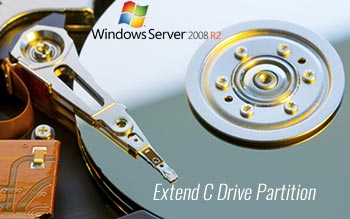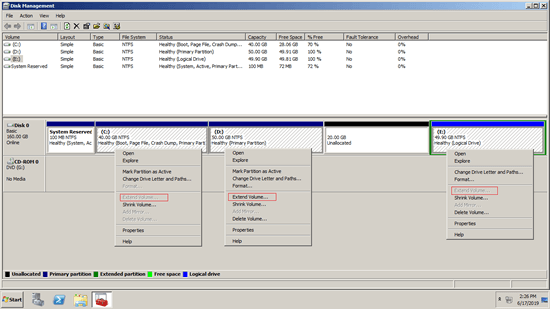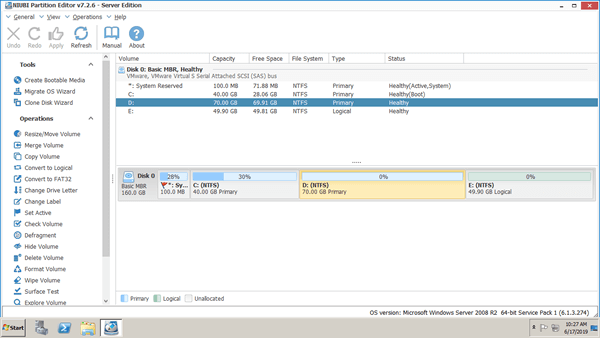In Windows 2008 server, the most common issue is that the system C drive is getting full, because many kinds of files are saving into C drive continuously. To solve this problem, if you contact support from server OEM manufacturer, they'll tell you to back up everything, delete and recreate partitions, finally restore from backup. How time consuming it is, you can increase C drive space without losing data. To extend C drive in Windows Server 2008 R2, there are 2 kinds of tools - inbuilt Disk Management and third party software. This article introduces full solution to extend C drive in Server 2008 R2 with both kinds of tools.

1. How to extend C drive in Server 2008 R2 without any software
Better than previous version, Windows Server 2008 Disk Management has new Extend Volume function to help increase partition size without losing data (in most cases).
However, it can only expand C drive by deleting the contiguous partition on the right (D: or E). If there's no right contiguous partition or you cannot delete it, you cannot extend C drive in Server 2008 with Disk Management.
Together with "Extend Volume", there's another new Shrink Volume function added, some people may ask why not shrinking D to expand C drive. Because unallocated space that shrunk from a partition via "Shrink Volume" cannot be extended to other partition with "Extend Volume" function. As you see in the screenshot, Extend Volume is disabled for C and E drive after shrinking D.
"Extend Volume" only works when there's contiguous unallocated space on the right side. You can't get such required unallocated space via "Shrink Volume" in Disk Management. When shrinking D: drive using Disk Management, unallocated space can only be made on the right of D, hence it is non adjacent to C drive. Meanwhile, it is on the left of another partition E, so Extend Volume is grayed out, too.
Steps to extend C drive in Server 2008 R2 via Disk Management:
- Transfer all files in D drive to other place. (Make sure no programs or Windows services are installed in this partition.)
- Press Windows and R on keyboard, type diskmgmt.msc and press "Enter" to open Disk Management.
- Right click drive D and select Delete Volume.
- Right click drive C and select Extend Volume.
- Click "Next" in pop-up "Extend Volume Wizard" window.
- Available disk space is selected by default, simply click "Next" till "Finish".
If the adjacent partition D is logical, you still can't extend C drive with Disk Management even after deleting D. If you want to extend C drive with diskpart cmd, you must delete D drive in advance, too.
Better than the Windows native tools. NIUBI Partition Editor can make unallocated space on either left or right when shrinking partition, and merge unallocated space to either contiguous or any nonadjacent partition on the same disk. Thus, you can increase C drive space without deleting other volume, Operating System, programs and anything else keeps the same with before.
2. How to increase C drive space in Server 2008 without losing data
There's potential system and data damage risk while resizing partitions with unreliable software. Because, all parameters of associated disk, partition and files must be modified correctly. Sometimes all files in the partition will be moved to new locations. Any software error or hardware issue could cause disaster. Therefore, you'd better make a backup first and run safe partition software.
Better than other disk partition tool, NIUBI Partition Editor has advanced technologies to protect system, partitions and data:
- Virtual Mode - all operations you do are listed as pending for preview, real disk partitions won't be changed until you click "Apply" to confirm.
- Cancel-at-will - if you applied wrong operations, it doesn't matter, you can cancel the ongoing operations without causing damage.
- 1 Second Rollback - if any error is detected while resizing partitions, it automatically reverts server to original status in a flash.
- Hot Clone - clone disk partition without server interruption, you may clone system disk before any operations or regularly as backup. If system disk goes wrong, you can boot from clone disk immediately without wasting a long time to restore.
- Advanced file-moving algorithm - move and extend partition 30% to 300% faster.
Download NIUBI Partition Editor, you'll see all disk with partition structure and other information on the right. Available operations to selected disk or partition are listed on the left and by right clicking.
Steps to extend C drive in Windows Server 2008 R2 with NIUBI Partition Editor:
- Right click D: drive and select "Resize/Move Volume", in the pop-up window, drag left border towards right or enter a value in the box of "Unallocated space before". Then part of free space will be converted to unallocated on the left side of D.
- Right click C: drive and select "Resize/Move Volume" again, drag right border towards right to combine this unallocated space.
- Click "Apply" on top left to execute.
Tips: If you want to extend C drive by shrinking the non adjacent partition E, there's an additional step to move unallocated space behind C drive. Watch the video how to operate.
If you use any types of hardware RAID arrays such as RAID 1/5/10, do not break array or do any operation to RAID controller, simply follow the same steps in the video.
3. How to extend C drive partition with another disk
When there's no available free space on the same disk, you cannot add space to C drive from another separate disk with any software. In that case, you can run NIUBI Partition Editor to copy disk to a larger one and enlarge C drive with extra disk space.
Follow the steps to extend C drive in Windows 2008 Server with a larger disk:
Another method is moving D or E to another disk, then delete this partition and add its space to C drive.
How to extend C drive for Server 2008 R2 in VMware/Hyper-V
If you run Windows 2008 as a guest server in VMware or Hyper-V virtual machine, firstly, check if there's plenty of free space on the same disk. If yes, simply install NIUBI Partition Editor to the virtual server and follow the steps in the first video above.
If there's not plenty of free space on the system disk, you can expand this virtual disk without copying to another one.
After expanding disk, additional space is shown as unallocated at the end of original disk. Follow the steps in first video to move unallocated space and add to C drive.
Besides shrinking partition and extending C drive in Windows Server 2008/2012/2016/2019/2022, NIUBI Partition Editor helps do many other disk partition management operations.



